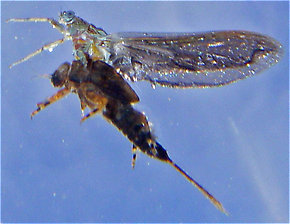Blog & Latest Updates
Fly Fishing Articles
Insects by Common Name


> > The Lower Yuba River
Closeup insects from the Lower Yuba River
Hydropsyche californica (Spotted Sedge) Caddisfly Larva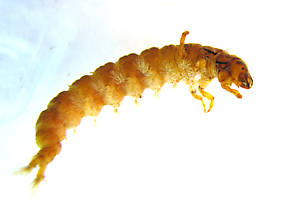 View 5 PicturesSize - 14 mm
View 5 PicturesSize - 14 mm
Condition - preserved
Habitat - cobble bottom, moderate flow run, at a depth of approx. 1 1/2 feet.
Key Characters - pair of large prosternal sclerites (Sclerite: A hard plate of chitinous material, such as those that form the exoskeletons of arthropods, uninterrupted by cracks or sutures.)
This is a very common taxon at this location. I collected using a kick net. In life, it is bright olive green ventrally, shading to a dull olive at its dorsal (Dorsal: Top.) abdominal surfaces. In the hand, the legs, thoraxic regions, and head appear medium chocolate brown. The stark contrast of the thoraxic plate's dark edges and light legs are effects of preserving. The plumouse anal hooks were duck down gray, not the color of the gills as appears in the preserved specimen.
The Lower Yuba River is a good habitat for this species, being a larger river with an open canopy. The Feather River just to the north of the Yuba system also finds H. californica in abundance. The other common Hydropsyche species in the area, Hydropsyche occidentalis, seems to prefer smaller, shaded streams.
Entoman
 View 5 PicturesSize - 14 mm
View 5 PicturesSize - 14 mmCondition - preserved
Habitat - cobble bottom, moderate flow run, at a depth of approx. 1 1/2 feet.
Key Characters - pair of large prosternal sclerites (Sclerite: A hard plate of chitinous material, such as those that form the exoskeletons of arthropods, uninterrupted by cracks or sutures.)
This is a very common taxon at this location. I collected using a kick net. In life, it is bright olive green ventrally, shading to a dull olive at its dorsal (Dorsal: Top.) abdominal surfaces. In the hand, the legs, thoraxic regions, and head appear medium chocolate brown. The stark contrast of the thoraxic plate's dark edges and light legs are effects of preserving. The plumouse anal hooks were duck down gray, not the color of the gills as appears in the preserved specimen.
The Lower Yuba River is a good habitat for this species, being a larger river with an open canopy. The Feather River just to the north of the Yuba system also finds H. californica in abundance. The other common Hydropsyche species in the area, Hydropsyche occidentalis, seems to prefer smaller, shaded streams.
Entoman
Collected March 9, 2011 from the Lower Yuba River in California
Added to Troutnut.com by Entoman on November 2, 2011
Added to Troutnut.com by Entoman on November 2, 2011
Rhithrogena morrisoni (Western March Brown) Mayfly Nymph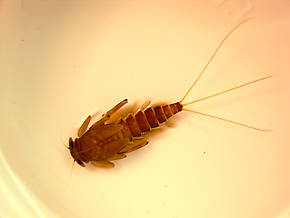 View 4 PicturesSize - (excluding tails) - 12 mm
View 4 PicturesSize - (excluding tails) - 12 mm
Status at time of photo - preserved, but photographed within days of capture.
W. C. Day, Aquatic Insects of California differentiates morrisoni nymphs by submedian pale dots on tergites (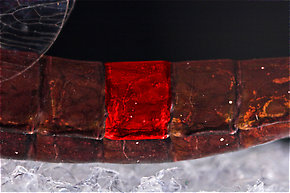 Tergite: The top (dorsal) part of a single segment on an insect's abdomen when it consists of a single chitinous plate (sclerite), or an individual sclerite if the segment has more than one.) 8 & 9, which look to be in evidence. This is one of the "super-hatches" on this river that can be prolific March through April.
Tergite: The top (dorsal) part of a single segment on an insect's abdomen when it consists of a single chitinous plate (sclerite), or an individual sclerite if the segment has more than one.) 8 & 9, which look to be in evidence. This is one of the "super-hatches" on this river that can be prolific March through April.
Entoman
 View 4 PicturesSize - (excluding tails) - 12 mm
View 4 PicturesSize - (excluding tails) - 12 mmStatus at time of photo - preserved, but photographed within days of capture.
W. C. Day, Aquatic Insects of California differentiates morrisoni nymphs by submedian pale dots on tergites (

One tergite of this Isonychia bicolor mayfly spinner is highlighted in red.
Entoman
Collected March 3, 2011 from the Lower Yuba River in California
Added to Troutnut.com by Entoman on November 1, 2011
Added to Troutnut.com by Entoman on November 1, 2011
Isoperla quinquepunctata (Little Yellow Stonefly) Little Yellow Stonefly Nymph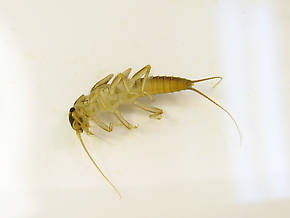 View 3 PicturesThe dorsal (Dorsal: Top.) patterning is quite unique.
View 3 PicturesThe dorsal (Dorsal: Top.) patterning is quite unique.
Entoman
 View 3 PicturesThe dorsal (Dorsal: Top.) patterning is quite unique.
View 3 PicturesThe dorsal (Dorsal: Top.) patterning is quite unique.Entoman
Collected March 15, 2013 from the Yuba River in California
Added to Troutnut.com by Entoman on April 20, 2013
Added to Troutnut.com by Entoman on April 20, 2013
Ephemerella dorothea infrequens (Pale Morning Dun) Mayfly Nymph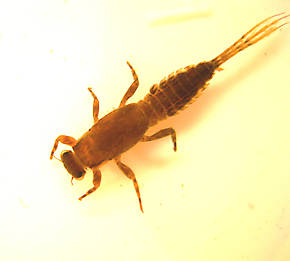 View 2 PicturesHabitat: Shallow riffle over cobble; approx. 1 ft. deep
View 2 PicturesHabitat: Shallow riffle over cobble; approx. 1 ft. deep
Size: 8.5 mm. Mature specimens have been captured as large as 10.5 mm.
Emergence schedule: Variable - starting as early as mid March and lasting as late as early June, depending on the year. Usual duration is at least several weeks or more.
Dun Association: Body is elusive pale creamy yellow w/ orange highlights, cream legs and tails, and dun wings
Specimen status in photo: Preserved
Collection method: Kick net
Comments: Extremely common in samples taken from this location. It's color in life was very close to as depicted in the photo; except for the gradual darkening of the abdominal segments as they progress posteriorly, which has been accentuated somewhat by the effects of preservation. Adult association is based upon capture of this taxon at various stages of emergence including: darkened wingcases, split thoraxic notums, and partially ecloded or ''stillborn (Stillborn: In fly fishing, a stillborn insect is one which got stuck in its nymphal or pupal shuck during emergence and floats helplessly on the surface instead of flying away. It is a specific class of cripple, although it is sometimes used interchangeably with that term.)'' specimens.
Entoman
 View 2 PicturesHabitat: Shallow riffle over cobble; approx. 1 ft. deep
View 2 PicturesHabitat: Shallow riffle over cobble; approx. 1 ft. deepSize: 8.5 mm. Mature specimens have been captured as large as 10.5 mm.
Emergence schedule: Variable - starting as early as mid March and lasting as late as early June, depending on the year. Usual duration is at least several weeks or more.
Dun Association: Body is elusive pale creamy yellow w/ orange highlights, cream legs and tails, and dun wings
Specimen status in photo: Preserved
Collection method: Kick net
Comments: Extremely common in samples taken from this location. It's color in life was very close to as depicted in the photo; except for the gradual darkening of the abdominal segments as they progress posteriorly, which has been accentuated somewhat by the effects of preservation. Adult association is based upon capture of this taxon at various stages of emergence including: darkened wingcases, split thoraxic notums, and partially ecloded or ''stillborn (Stillborn: In fly fishing, a stillborn insect is one which got stuck in its nymphal or pupal shuck during emergence and floats helplessly on the surface instead of flying away. It is a specific class of cripple, although it is sometimes used interchangeably with that term.)'' specimens.
Entoman
Collected March 21, 2011 from the Lower Yuba River in California
Added to Troutnut.com by Entoman on November 1, 2011
Added to Troutnut.com by Entoman on November 1, 2011
Isoperla quinquepunctata (Little Yellow Stonefly) Little Yellow Stonefly Nymph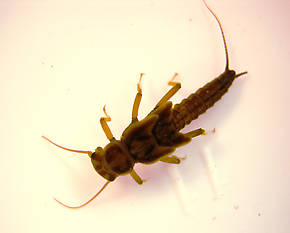 View 2 PicturesSize - (excluding tails) - 10 mm
View 2 PicturesSize - (excluding tails) - 10 mm
Status at time of photo - preserved but no discernible color change as specimen was captured only a few days earlier.
Key characters - unique pattern on dorsal (Dorsal: Top.) head and thorax (Thorax: The thorax is the middle part of an insect's body, in between the abdomen and the head, and to which the legs and wings are attached.); dark medial (Medial: Toward the middle of the body.) terga (Tergum: the dorsal part of an abdominal segment or segments (terga). Also used to describe the entire abdominal dorsum or the thoracic dorsal segments of Odonata.) stripe between two paler stripes
This species is very common in west slope north Sierra watersheds. Richard W. Baumann & Boris C. Kondratieff did a study on the same section and at the same time of year (APRIL 25-29, 2010) where this specimen was taken. No other species of Isoperla were reported from this location and quinquepunctata was very abundant. Their hatches can be very heavy some Springs.
Entoman
 View 2 PicturesSize - (excluding tails) - 10 mm
View 2 PicturesSize - (excluding tails) - 10 mmStatus at time of photo - preserved but no discernible color change as specimen was captured only a few days earlier.
Key characters - unique pattern on dorsal (Dorsal: Top.) head and thorax (Thorax: The thorax is the middle part of an insect's body, in between the abdomen and the head, and to which the legs and wings are attached.); dark medial (Medial: Toward the middle of the body.) terga (Tergum: the dorsal part of an abdominal segment or segments (terga). Also used to describe the entire abdominal dorsum or the thoracic dorsal segments of Odonata.) stripe between two paler stripes
This species is very common in west slope north Sierra watersheds. Richard W. Baumann & Boris C. Kondratieff did a study on the same section and at the same time of year (APRIL 25-29, 2010) where this specimen was taken. No other species of Isoperla were reported from this location and quinquepunctata was very abundant. Their hatches can be very heavy some Springs.
Entoman
Collected March 21, 2011 from the Lower Yuba River in California
Added to Troutnut.com by Entoman on November 1, 2011
Added to Troutnut.com by Entoman on November 1, 2011
Start a Discussion of the Lower Yuba River:
Top 10 Fly Hatches
Top Gift Shop Designs
Eat mayflies.
Top Insect Specimens
Miscellaneous Sites
Troutnut.com is copyright © 2004-2024 Jason
Neuswanger (email Jason). See my FAQ for information about use of my images.
 privacy policy
privacy policy

